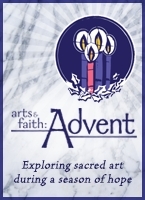Arts & Faith: Week 3 of Advent, Cycle C
Domenico Ghirlandaio, “Preaching of St. John the Baptist,” 1490

Domenico Ghirlandaio’s fresco of John the Baptist preaching is one of a series he created for the Tornabuoni Chapel of Florence’s Santa Maria Novella Church. In this scene, we meet John the Baptist preaching to the crowds, standing on a rock and holding a cross staff with one hand, while instructing with his other. As he turns his attention to the people on the right of the scene, we can imagine him articulating the admonitions listed in Luke’s Gospel in response to the question, “Teacher, what should we do?” In his teaching to share goods justly and avoid extortion and excessive taxing, John is preparing the way for the Lord.
As John prepares the way by his preaching, Christ appears on the top left, heading down a path toward the crowd. Not one person notices him. At the moment, the focus is still on John’s preparatory role, on his preaching ministry that prepares the expectant hearts of the crowd for the advent of the Lord. Christ’s downcast gaze and crossed hands in contrast with John’s more active expression and hand gestures also underscore the focus of the moment.
To the left of the scene we meet a gathering of women, a feature characteristic of Ghirlandaio’s work. They too are engaged in listening to John. Two of them are pictured from the back, one standing and one seated at the foot of the rock on which John stands. The seated woman is especially evocative; her body is turned and directed toward John, even as a child at the foot of the prophet reaches out to get her attention. This detail alludes to conversion away from the pagan classical world that the child represents to the anticipation of the Gospel heralded by John. Seeing the woman’s back, the viewer is called to follow her example and to find oneself in her company in the crowd surrounding John.
In the midst of the elegant and colorful crowd, John the Baptist stands on a rock in his camelhair shirt and preaches the coming of Christ. His words call us to turn too, make way for the Lord, and let our hearts be filled with joyful expectation as he nears.

Commentary is by Daniella Zsupan-Jerome, director of ministerial formation at Saint John's University School of Theology and Seminary.
Related Ignatian reflection on this week’s art
Week 3 of Advent, Cycle C

Using Imagination in Prayer (Ages 9–12)
Give children time to reflect on the art. Invite children to imagine they are in the crowd John the Baptist is addressing. Have them close their eyes and prayerfully consider: What is John the Baptist saying? What does he say we students should do to grow closer to the Lord? What am I being called to change in my life to be ready to meet Jesus? After giving children time to pray, say: Take a moment to pray a silent prayer thanking God for sending messengers to help us be better people.
Advent Poetry (Ages 11-14)
Have small groups brainstorm a list of words and phrases associated with John the Baptist and Advent. Ask young people to use the list as inspiration and write a poem about John the Baptist that reflects his character and the message of Advent preparation. Invite volunteers to read aloud their completed poems.

